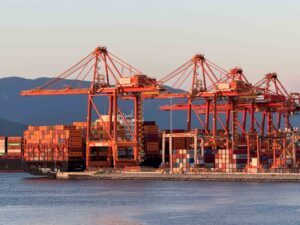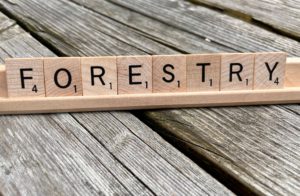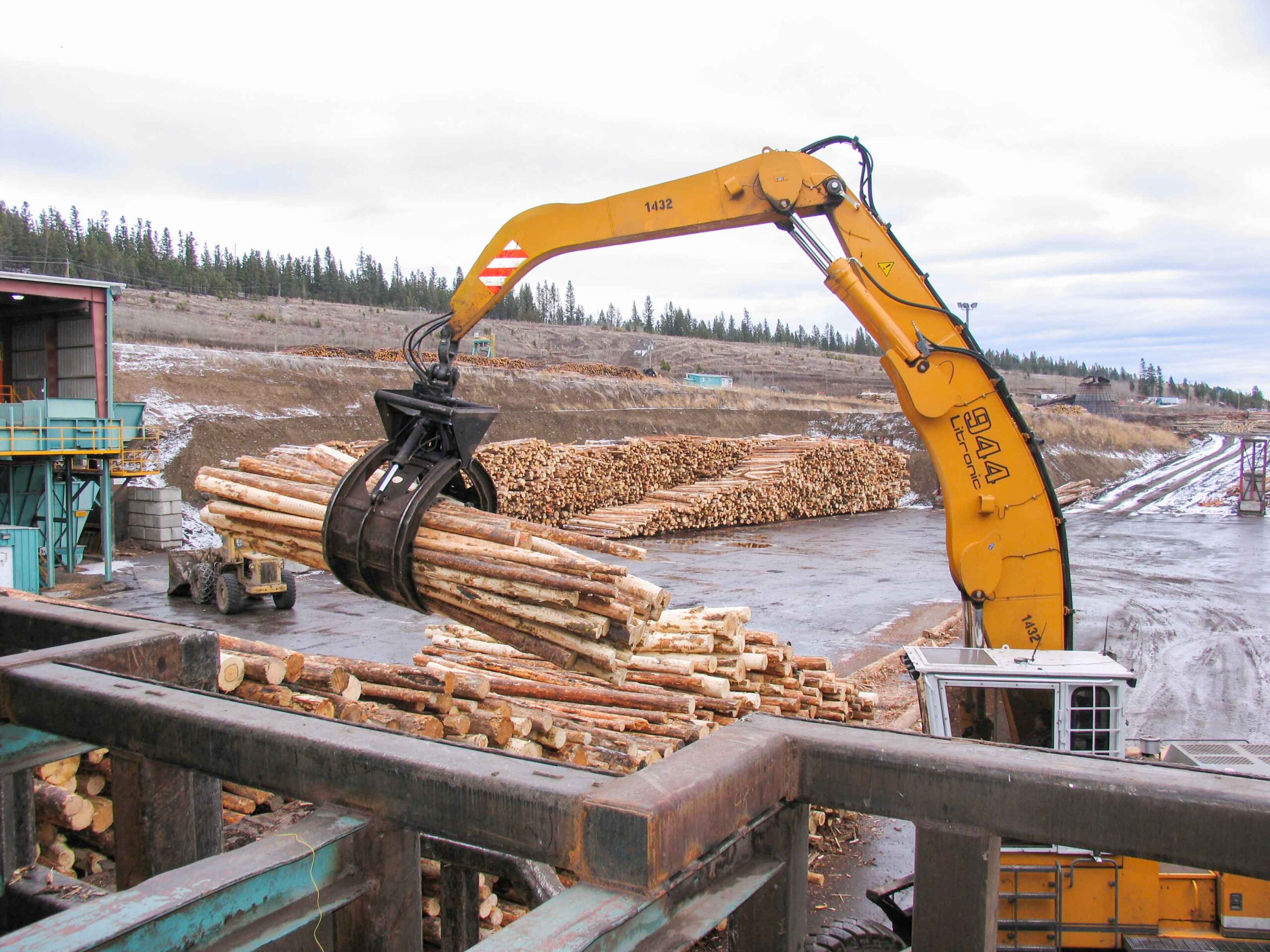 Interfor’s lumber mill in Grand Forks, BC to take an extended maintenance shutdown. In related news: MLA Ward Stamer says BC’s industry is in crisis; Trump and Carney avoid collision (save for a nasty comment or two); FPAC’s Derek Nighbor says lumber can’t be left behind; and lumber production continues to outpace demand. Meanwhile: Unifor is reassured on future of Domtar’s Kénogami plant; Sappi and UPM plan to reduce their paper production in Finland; and the EU imposes duties on Brazil plywood.
Interfor’s lumber mill in Grand Forks, BC to take an extended maintenance shutdown. In related news: MLA Ward Stamer says BC’s industry is in crisis; Trump and Carney avoid collision (save for a nasty comment or two); FPAC’s Derek Nighbor says lumber can’t be left behind; and lumber production continues to outpace demand. Meanwhile: Unifor is reassured on future of Domtar’s Kénogami plant; Sappi and UPM plan to reduce their paper production in Finland; and the EU imposes duties on Brazil plywood.
In Forestry/Climate news: Interfor’s news has BC Timber Sales bracing for selling problems; US groups urge Brussels not to cave on deforestation law; and Amazon rainforest hits record CO2 emissions from forest fires.
Finally, Rooted in Strength: Forestry Technician program in Pembroke, Ontario enters 58th year.
Kelly McCloskey, Tree Frog News Editor

 Prime Minister Mark Carney said Canadian and American officials are currently “negotiating terms” of a deal on tariffs a day after he met with the U.S. president to try and bring the trade war to a close — and Canada will come out ahead when the two sides come to an agreement. Speaking in question period … about what he accomplished out of his Oval Office sit-down with U.S. President Donald Trump, Carney said Canada already “has the best deal with the Americans” — most products are still being sold into the U.S. tariff-free despite Trump’s trade action — and “we will get an even better deal.” …Conservative Leader Pierre Poilievre said Carney “pathetically” offered up “a trillion-dollar gift” to Trump when speaking with the president, and it was an instance of him “bowing before the president in weakness.” …Daniel Smith said Carney is developing a rapport with the president…
Prime Minister Mark Carney said Canadian and American officials are currently “negotiating terms” of a deal on tariffs a day after he met with the U.S. president to try and bring the trade war to a close — and Canada will come out ahead when the two sides come to an agreement. Speaking in question period … about what he accomplished out of his Oval Office sit-down with U.S. President Donald Trump, Carney said Canada already “has the best deal with the Americans” — most products are still being sold into the U.S. tariff-free despite Trump’s trade action — and “we will get an even better deal.” …Conservative Leader Pierre Poilievre said Carney “pathetically” offered up “a trillion-dollar gift” to Trump when speaking with the president, and it was an instance of him “bowing before the president in weakness.” …Daniel Smith said Carney is developing a rapport with the president… President Trump has warned of disaster if the Supreme Court overturns his signature tariffs. For starters, it would unleash a bureaucratic nightmare involving reams of refund paper checks. Should the court uphold a US Court of Appeals ruling that Trump’s country-based tariffs are illegal, the government could owe the bulk of the $165 billion in duties collected so far this fiscal year back to companies that paid them. But they won’t have an easy time getting their money back; refunds are typically issued slowly and while the administration could streamline the process, experts fear that’s unlikely. …That means Trump likely won’t part with the funds easily if the tariffs are struck down, and the administration is expected to move quickly to reimpose levies using other legal authorities if that happens. The Supreme Court is expected to hear arguments in November in the case.
President Trump has warned of disaster if the Supreme Court overturns his signature tariffs. For starters, it would unleash a bureaucratic nightmare involving reams of refund paper checks. Should the court uphold a US Court of Appeals ruling that Trump’s country-based tariffs are illegal, the government could owe the bulk of the $165 billion in duties collected so far this fiscal year back to companies that paid them. But they won’t have an easy time getting their money back; refunds are typically issued slowly and while the administration could streamline the process, experts fear that’s unlikely. …That means Trump likely won’t part with the funds easily if the tariffs are struck down, and the administration is expected to move quickly to reimpose levies using other legal authorities if that happens. The Supreme Court is expected to hear arguments in November in the case. Plans to institute an “extended maintenance shutdown” of the Interfor lumber mill in Grand Forks is not a permanent shutdown, according to the company. On Sept. 4 Interfor Corporation announced plans to reduce its lumber production by approximately 145 million board feet at all operations between September and December of 2025, representing approximately 12 per cent of its normal output. The temporary curtailments will be through a combination of reduced operating hours, prolonged holiday breaks, reconfigured shifting schedules and extended maintenance shut-downs. The curtailments are expected to impact all of Interfor’s operating regions, with both the Canadian and U.S. operations expected to reduce their production levels by approximately 12 per cent each. “The curtailments are in response to persistently weak market conditions and ongoing economic uncertainty,” read a statement from the company.
Plans to institute an “extended maintenance shutdown” of the Interfor lumber mill in Grand Forks is not a permanent shutdown, according to the company. On Sept. 4 Interfor Corporation announced plans to reduce its lumber production by approximately 145 million board feet at all operations between September and December of 2025, representing approximately 12 per cent of its normal output. The temporary curtailments will be through a combination of reduced operating hours, prolonged holiday breaks, reconfigured shifting schedules and extended maintenance shut-downs. The curtailments are expected to impact all of Interfor’s operating regions, with both the Canadian and U.S. operations expected to reduce their production levels by approximately 12 per cent each. “The curtailments are in response to persistently weak market conditions and ongoing economic uncertainty,” read a statement from the company.



 The European Commission proposed preliminary antidumping duties on imports of softwood plywood from Brazil, following an investigation launched
The European Commission proposed preliminary antidumping duties on imports of softwood plywood from Brazil, following an investigation launched  President Trump unveiled sweeping tariffs on imported lumber and wood products that his administration says are needed to protect the US economy and boost domestic manufacturing. Starting Oct. 14, softwood lumber will face 10% duties, while kitchen cabinets, bathroom vanities, and other finished wood goods will be hit with 25% tariffs that rise further in January. The biggest blow will fall on Canada, the US’s top lumber supplier, whose lumber exports are already subject to separate duties totaling 35.19%. …Though Canada dominates exports of lumber to the US, many other countries export wood products to the US. The Section 232 tariffs on lumber and wood products affect them in varying ways; some countries benefit from trade deals with the US that cap the rates, and others bear the full brunt. …Though lumber accounts for less than 20% of building costs, the National Association of Homebuilders has long said that restrictions on Canadian lumber translate to higher construction costs. [to access the full story a Bloomberg subscription is required]
President Trump unveiled sweeping tariffs on imported lumber and wood products that his administration says are needed to protect the US economy and boost domestic manufacturing. Starting Oct. 14, softwood lumber will face 10% duties, while kitchen cabinets, bathroom vanities, and other finished wood goods will be hit with 25% tariffs that rise further in January. The biggest blow will fall on Canada, the US’s top lumber supplier, whose lumber exports are already subject to separate duties totaling 35.19%. …Though Canada dominates exports of lumber to the US, many other countries export wood products to the US. The Section 232 tariffs on lumber and wood products affect them in varying ways; some countries benefit from trade deals with the US that cap the rates, and others bear the full brunt. …Though lumber accounts for less than 20% of building costs, the National Association of Homebuilders has long said that restrictions on Canadian lumber translate to higher construction costs. [to access the full story a Bloomberg subscription is required] North America’s softwood lumber market looks likely to end 2025 no more settled than it was at the beginning. Producers and buyers alike continue navigating a landscape shaped by fluctuating demand, shifting trade patterns, and an uncertain housing outlook. Despite modest production declines in early 2025, the lumber market remains oversupplied. Mills across the US and Canada are contending with high inventories built up earlier in the year. Expectations of tariff hikes spurred an early rush of exports from Canada to the US, flooding the market while demand was soft. However, in the first half of 2025 softwood lumber exports from Canada to the US declined, while US imports from Europe in the first seven months of 2025 increased by 6% year-over-year. Underlying these supply pressures is a US housing market stuck in the doldrums. August saw an 8.5% decline in overall housing starts, with single-family construction down nearly 7%.
North America’s softwood lumber market looks likely to end 2025 no more settled than it was at the beginning. Producers and buyers alike continue navigating a landscape shaped by fluctuating demand, shifting trade patterns, and an uncertain housing outlook. Despite modest production declines in early 2025, the lumber market remains oversupplied. Mills across the US and Canada are contending with high inventories built up earlier in the year. Expectations of tariff hikes spurred an early rush of exports from Canada to the US, flooding the market while demand was soft. However, in the first half of 2025 softwood lumber exports from Canada to the US declined, while US imports from Europe in the first seven months of 2025 increased by 6% year-over-year. Underlying these supply pressures is a US housing market stuck in the doldrums. August saw an 8.5% decline in overall housing starts, with single-family construction down nearly 7%.
 WASHINGTON, DC – Fannie Mae published the results of its September 2025
WASHINGTON, DC – Fannie Mae published the results of its September 2025 

 CASTLEGAR, BC — A BC Timber Sales manager for the Kootenay-Boundary admits they may have a hard time selling wood in the coming months as local mills cope with additional U.S. tariffs. George Edney told Castlegar city council this week that his organization, which manages and auctions 20% of the timber on Crown land, will have sales opening next week in the Boundary. …Interfor has curtailed its Grand Forks operations indefinitely due to “persistently weak market conditions.” …Edney said if the wood they offer in the Boundary doesn’t sell at the upset price, they can drop the price and try again, or they can withdraw it altogether, although typically they want the wood in the market. …Edney said they sold 581,000 cubic meters that BC Timber Sales in the Kootenays in 2024-25. Their target volume for 2025-26 is 715,000 cubic metres.
CASTLEGAR, BC — A BC Timber Sales manager for the Kootenay-Boundary admits they may have a hard time selling wood in the coming months as local mills cope with additional U.S. tariffs. George Edney told Castlegar city council this week that his organization, which manages and auctions 20% of the timber on Crown land, will have sales opening next week in the Boundary. …Interfor has curtailed its Grand Forks operations indefinitely due to “persistently weak market conditions.” …Edney said if the wood they offer in the Boundary doesn’t sell at the upset price, they can drop the price and try again, or they can withdraw it altogether, although typically they want the wood in the market. …Edney said they sold 581,000 cubic meters that BC Timber Sales in the Kootenays in 2024-25. Their target volume for 2025-26 is 715,000 cubic metres. US civil society groups are urging the European Commission to resist Washington’s pressure to delay the EU’s deforestation regulation (EUDR) or tweak the rules to grant the country preferential treatment, according to a letter seen by Euractiv. The missive, sent this morning to Commission President Ursula von der Leyen and the Commissioners responsible for green rules, the economy and trade, warns against any backtracking. “We are particularly concerned by the Commission’s apparent willingness to offer the U.S. special treatment under the EUDR as part of ongoing EU-U.S. trade negotiations,” the letter reads. The organisations refer to the joint statement issued by Brussels and Washington in September, which labels the US as posing “negligible risk to global deforestation.” Rick Jacobsen, senior manager for commodities policy at the US NGO Environmental Investigation Agency, told Euractiv that US interests have “ramped up the pressure campaign” to weaken the law before it even comes into force.
US civil society groups are urging the European Commission to resist Washington’s pressure to delay the EU’s deforestation regulation (EUDR) or tweak the rules to grant the country preferential treatment, according to a letter seen by Euractiv. The missive, sent this morning to Commission President Ursula von der Leyen and the Commissioners responsible for green rules, the economy and trade, warns against any backtracking. “We are particularly concerned by the Commission’s apparent willingness to offer the U.S. special treatment under the EUDR as part of ongoing EU-U.S. trade negotiations,” the letter reads. The organisations refer to the joint statement issued by Brussels and Washington in September, which labels the US as posing “negligible risk to global deforestation.” Rick Jacobsen, senior manager for commodities policy at the US NGO Environmental Investigation Agency, told Euractiv that US interests have “ramped up the pressure campaign” to weaken the law before it even comes into force. In 2024, the Amazon Rainforest underwent its most devastating forest fire season in more than two decades. According to a new study by the European Commission’s Joint Research Centre, the fire-driven forest degradation released an estimated 791 million metric tons of carbon dioxide in 2024, a sevenfold increase compared with the previous two years. The carbon emissions from fires in 2024 surpassed those from deforestation for the first time on record. Brazil was the largest contributor, accounting for 61% of these emissions, followed by Bolivia with 32%, the study found. “The escalating fire occurrence, driven by climate change and unsustainable land use, threatens to push the Amazon towards a catastrophic tipping point,” the authors write. …The researchers estimated that the total emissions from deforestation and fire-driven degradation in the Amazon in 2024 was 1,416 million metric tons of CO2. This is higher than Japan’s CO2 emissions in 2022, which ranked fifth after China, the U.S., India and Russia.
In 2024, the Amazon Rainforest underwent its most devastating forest fire season in more than two decades. According to a new study by the European Commission’s Joint Research Centre, the fire-driven forest degradation released an estimated 791 million metric tons of carbon dioxide in 2024, a sevenfold increase compared with the previous two years. The carbon emissions from fires in 2024 surpassed those from deforestation for the first time on record. Brazil was the largest contributor, accounting for 61% of these emissions, followed by Bolivia with 32%, the study found. “The escalating fire occurrence, driven by climate change and unsustainable land use, threatens to push the Amazon towards a catastrophic tipping point,” the authors write. …The researchers estimated that the total emissions from deforestation and fire-driven degradation in the Amazon in 2024 was 1,416 million metric tons of CO2. This is higher than Japan’s CO2 emissions in 2022, which ranked fifth after China, the U.S., India and Russia.